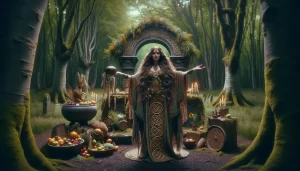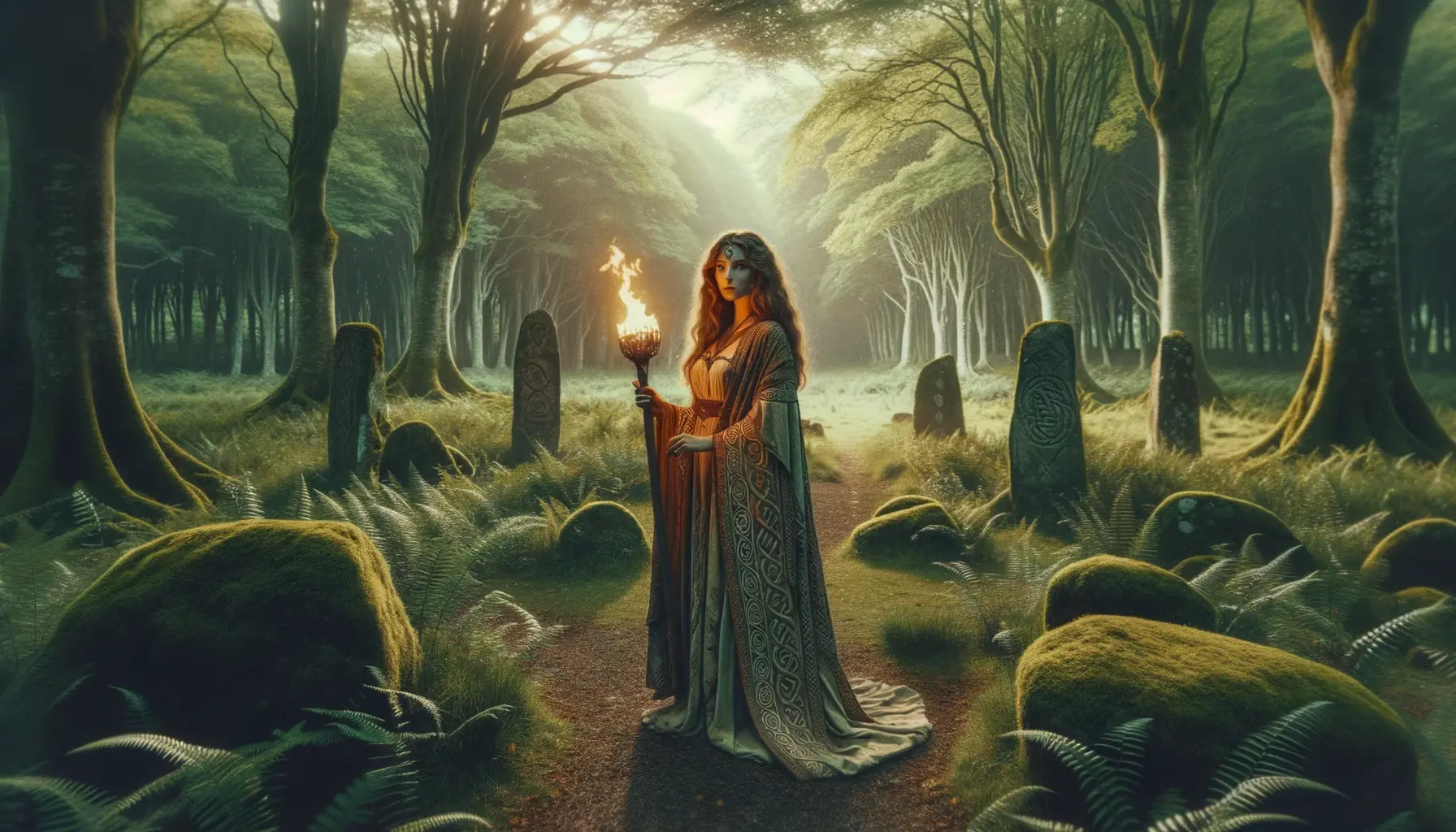Brigid is a Celtic goddess who has been worshipped for centuries in Ireland and the British Isles. She is one of the most prominent members of the Irish pantheon and is associated with a wide range of attributes, including healing, poetry, smithcraft, and fertility. Brigid is often depicted as a beautiful woman with golden hair, carrying a flame or a cross.
As a goddess of healing, Brigid was believed to have the power to cure illnesses and injuries. She was also associated with childbirth and was often called upon to bless pregnant women and newborn babies. Goddess Brigid was also a patron of poets, and many bards would invoke her before beginning their work. In addition, she was revered as a goddess of fire and was said to preside over the hearth and home.
Today, Goddess Brigid is still venerated by many people who follow Celtic traditions. Her feast day, which falls on February 1st, is celebrated as Imbolc, one of the four major Celtic seasonal festivals. Many people light candles or bonfires in her honor, and some leave offerings of milk or butter for her at the hearth. As a goddess of healing and inspiration, Brigid continues to inspire people to this day.
Origins and Mythology
Irish Goddess Brigid
Goddess Brigid, or Brigit, is a goddess of pre-Christian Ireland. She is one of the most prominent deities in the Irish Celtic pantheon, and among the Tuatha Dé Danann, she was one of the most popular goddesses. In Irish mythology, Brigid is the daughter of the Dagda, the god of the earth and fertility, and the wife of Bres, with whom she had a son named Ruadán.
Brigid is associated with the spring season and is often depicted as a goddess of fertility, healing, and poetry. Her feast day was celebrated on February 1, which was also the date of the pagan festival of Imbolc, marking the beginning of spring and the time when the ewes came into milk.
Celtic Goddess
Brigid is not only known as a deity in Ireland but also in other Celtic cultures. In Celtic mythology, she is associated with the fire element and is considered a goddess of the hearth, home, and crafts. Brigid is also known as a goddess of water, particularly of wells and springs.
According to legend, Brigid had the ability to transform into a swan, which symbolizes purity, grace, and beauty. She is often depicted holding a flame or a torch, representing her association with fire and light.
British Isles Goddess
Brigid’s influence extended beyond Ireland and into the British Isles. In Scotland, she was known as Bride, and her festival was celebrated on the same day as Imbolc. In Wales, she was known as Ffraid, and her festival was celebrated on May 1, known as Calan Mai.

Symbols and Associations
Goddess Brigid is associated with several symbols that represent different aspects of her character and power. These symbols have evolved over time and may vary depending on the region and culture.
One of the most prominent symbols of Brigid is the well. Wells are considered sacred sites in Celtic mythology and are associated with healing, purification, and fertility. Brigid is often depicted as a guardian of wells and springs, and her presence is said to bring luck and prosperity.
Water is another important symbol of Brigid. As a goddess of fertility and new life, Brigid is often associated with the element of water. She is said to have the power to heal and purify water, and her blessings are sought after for safe childbirth and healthy crops.
Fire is perhaps the most well-known symbol of Brigid. As a goddess of the hearth and home, Brigid is associated with the sacred fire that burns in every household. She is also associated with the sun, which represents warmth, light, and new beginnings.
The triple goddess is another important symbol of Brigid. She is said to have three aspects: the maiden, the mother, and the crone. Each aspect represents a different stage of life and is associated with different qualities and powers.
The oak tree is also associated with Brigid. The oak is a symbol of strength, endurance, and wisdom, and is often seen as a sacred tree in Celtic mythology.
Finally, Brigid is associated with the fiery arrow, which represents her power and strength. The fiery arrow is said to be a symbol of her ability to protect and defend her people, and is often used in rituals and ceremonies to invoke her blessings.
Roles and Domains
Brigid, the Celtic goddess, was known for her many roles and domains. She was a mother goddess, protector, midwife, and healer. Brigid was also associated with poetry, power, magic, fertility, wisdom, passion, and motherhood.
As a mother goddess, Brigid was revered for her nurturing and caring nature. She was believed to be the protector of children and childbirth, and many women sought her assistance during labor. Brigid was also known as a midwife, helping to bring new life into the world.
In addition to her roles as a mother and protector, Brigid was also a healer. She was associated with the healing powers of fire and water, and her followers often sought her assistance in curing illnesses and injuries.
Brigid was also a goddess of poetry and wisdom. She was believed to inspire poets and bards, and her followers often sought her guidance in matters of knowledge and understanding.
Finally, Brigid was associated with fertility and passion. She was believed to have the power to bring new life into the world, and her followers often sought her assistance in matters of love and romance.
Festival of Imbolc
Imbolc is a traditional Gaelic festival that marks the beginning of spring and is celebrated on February 1st. It is also known as Saint Brigid’s Day, and it is believed to be the day when the Celtic goddess Brigid transforms the winter into spring. Imbolc is a time of new beginnings, purification, and renewal.
During Imbolc, people prepare for the arrival of spring by cleaning their homes and performing rituals of purification. They also light candles and fires to symbolize the return of the sun and the longer days ahead. Imbolc is also a time for celebrating the fertility of the land and the animals that will soon give birth.
Saint Brigid, one of Ireland’s patron saints, is also celebrated during Imbolc. She is revered as a symbol of healing, fertility, and agriculture. Many people make Brigid crosses, which are made of rushes or straw and are hung in homes to protect them from harm.
Food is an important part of Imbolc celebrations, and traditional dishes include colcannon, a potato and cabbage dish, and barmbrack, a fruitcake, all of which make up a part of Irish culture and traditions. These dishes are often shared with friends and family as a symbol of the community coming together to celebrate the arrival of spring.

Rituals and Offerings
Brigid is a goddess associated with healing, poetry, and smithcraft. She is also associated with fire, water, and the hearth. In many cultures, Brigid is honored with rituals and offerings.
One common offering to Brigid is milk, which is associated with her role as a nurturing mother figure. Other offerings include candles, blackberries, water, bread, coins, herbal teas, spears and arrows, ivy, and heather. These offerings can be placed on an altar dedicated to Brigid or left at a sacred site associated with her.
Rushes are also associated with Brigid and are often used in rituals and offerings. They can be woven into crosses or other shapes and hung in doorways or homes to protect against evil spirits. Brigid’s cross is a symbol of protection and is still commonly used in Ireland today.
Keening is another ritual associated with Brigid. Keening is a form of lamentation used to mourn the dead. Brigid is said to be the guardian of the dead and is often called upon during funerals and wakes.
Brigid is also associated with the hearth and is said to bless homes with warmth and light. In some cultures, a Brigid doll is made from straw and placed near the hearth to bring good luck and prosperity to the home.
Coins are also associated with Brigid and are often used in divination rituals. Coins can be tossed or placed on a table and interpreted based on their position and orientation.
Frequently Asked Questions
What is the significance of the goddess Brigid in Celtic mythology?
Brigid is one of the most prominent goddesses in Celtic mythology. She is associated with many aspects of life, including healing, fertility, poetry, and smithcraft. She was also believed to be a goddess of fire, water, and the hearth. Brigid was revered throughout the Celtic world, with many different cultures having their own unique ways of worshipping her.
What are some common symbols associated with Brigid?
Some common symbols associated with Brigid include fire, water, the sun, the moon, and the serpent. She is also often depicted wearing a crown of flames or holding a flame in her hand. The number three is also significant to Brigid, as she is sometimes seen as a triple goddess.
How is Brigid celebrated in modern Paganism?
In modern Paganism, Brigid is often celebrated on Imbolc, which falls on February 1st or 2nd. This holiday marks the beginning of spring and is associated with the return of the sun. Many Pagans honor Brigid with offerings of flowers, candles, and milk. Some also perform rituals to ask for her blessings in areas such as healing, creativity, and protection.
What is the connection between Brigid and the elements of fire and water?
Brigid is often associated with the elements of fire and water. She was believed to be a goddess of fire, especially in relation to the hearth and forge. She was also associated with water, particularly with wells and springs. This connection to both fire and water represents Brigid’s duality as a goddess of both creation and destruction.
What are some traditional offerings or prayers associated with Brigid?
Traditional offerings to Brigid include milk, butter, and grains. Some also offer flowers or candles in her honor. Prayers to Brigid often ask for her blessings in areas such as healing, creativity, and protection. Some also ask for her guidance in matters related to the home and hearth.
Check out more about the Celtic Goddess of healing in this video below:

